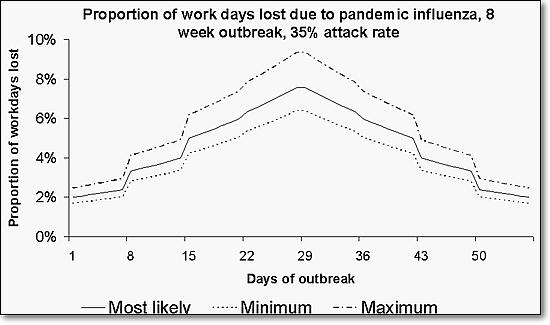FluWorkLoss 1.0
Download FluWorkLoss Spreadsheet [2 MB]
Download FluWorkLoss Manual [1 MB, 35 pages]
Pandemic influenza can overwhelm a community, causing very serious public health, social, and economic problems. Over a period of 30 years, between 1976 and 2006, estimates of influenza-associated deaths in the United States range from a low of about 3,000 to a high of about 49,000 people. And, on average, more than 200,000 people are hospitalized in the United States each year due to complications related to seasonal influenza. However, because illness rates during a pandemic are likely to be 2-5 times higher than a typical influenza season, special planning for work loss during pandemics is critical to maintain continuity of operations in a severe pandemic.
FluWorkLoss estimates the potential number of days lost from work due to an influenza pandemic. Users can change almost any input value, such as the number of workdays assumed lost when a worker becomes ill or the number of workdays lost due to a worker staying home to care for a family member. Users can also change the length and virulence of the pandemic so that a range of possible impacts can be estimated. FluWorkLoss provides a range of estimates of total workdays lost, as well as graphic illustrations of the workdays lost by week and percentage of total workdays lost to influenza-related illnesses. An example of the results produced by FluWorkLoss is given below.
Example of output from FluWorkLoss

Case Study
The manual contains a case study illustrating how to use FluWorkLoss to estimate the potential impact of the next influenza pandemic on the availability of human blood donors. This case study exemplifies how users can adapt FluWorkLoss to estimate the potential impact of pandemic influenza for a wide variety of situations.
System Requirements
- Windows* operating system (MS Windows 2000 or newer)
- Microsoft Excel (MS Office 2000 or newer)
- 486 Pentium processor and at least 128MB RAM
- 2 MB of hard drive storage space
* MS Windows and Office is a copyrighted product produced by Microsoft Corporation, WA. Use of trade names and commercial sources is for identification only and does not imply endorsement by the U.S. Department of Health and Human Services.
Instructions for Downloading
Before loading and starting FluWorkLoss, you must change Excel's security level as described below:
- Open a blank Excel spreadsheet.
- Click Tools and then click Macro, choose Security
- Set Security Level to Medium.
- Click OK. You are now ready to open FluWorkLoss (once you have downloaded the program – see below).
- Double click to open FluWorkLoss file.
- When asked to Disable Macros or Enable Macros, click Enable Macros.
Downloading the Files
*We recommend downloading and saving the FluWorkLoss Spreadsheet to your computer, then open the spreadsheet from your computer. This will allow the spreadsheet to open in Excel instead of your web browser.
- Page last reviewed: August 22, 2016
- Page last updated: August 31, 2011
- Content source:
- Centers for Disease Control and Prevention, National Center for Immunization and Respiratory Diseases (NCIRD)
- Page maintained by: Office of the Associate Director for Communication, Digital Media Branch, Division of Public Affairs


 ShareCompartir
ShareCompartir